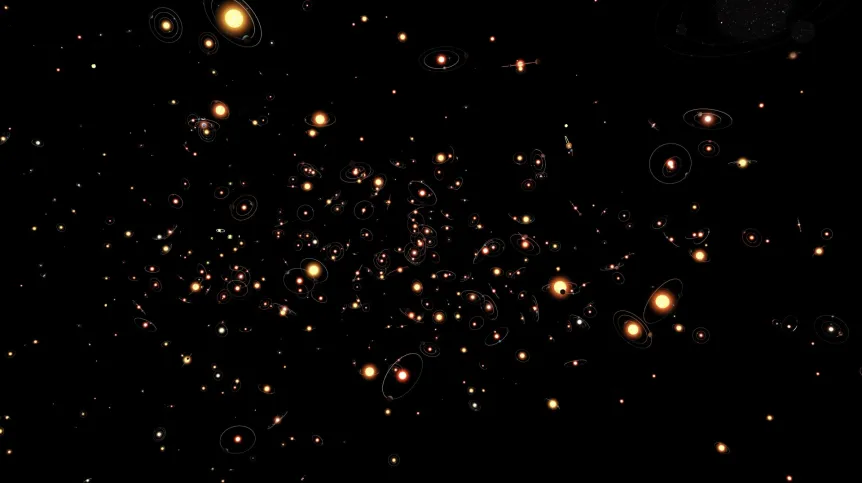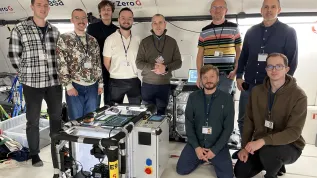
Cold super-Earths are common in planetary systems: they occur in every third system around the stars in the Milky Way, according to research involving scientists from the Astronomical Observatory of the University of Warsaw.
An international team of scientists investigated low-mass extrasolar planets orbiting their parent stars at large distances. The researchers involved in the project included astronomers from the large-scale sky survey project OGLE (Optical Gravitational Lensing Experiment) of the Astronomical Observatory of the University of Warsaw, led by Professor Andrzej Udalski. The results were published in the journal „Science” (https://doi.org/10.1126/science.adn6088).
The scientists have found that so-called cold super-Earths are common components of planetary systems: on average, they are found in every third system around stars in the Milky Way. Super-Earths are extrasolar celestial bodies with masses between the masses of Earth and Neptune (approx. 17 Earth masses), belonging to the type of rocky planets.
The researchers remind that just 30 years ago, no planets had yet been discovered orbiting stars similar to our Sun. The first discoveries were made in the 1990s, and now they are routinely identified thanks to the development of new detection techniques such as the transit and gravitational microlensing methods.
The researchers point out that planet detection techniques have limitations. It is easiest to detect systems in which planets orbit relatively close to their stars, meaning the majority of known exoplanets are those with orbital periods (the time it takes an object to complete an orbit) shorter than one year. Among them, super-Earths are particularly abundant.
Less is known about distant regions of planetary systems, located beyond the so-called snow line, 1-2 astronomical units from the star, where water is present as ice and the conditions are conducive to the formation of gas giants, such as Jupiter or Saturn. The researchers point out that only gravitational microlensing enables the detection of planets in these remote regions. Microlensing has already revealed how often massive, Jupiter-like planets occur on wide orbits. But whether smaller, lower-mass planets (super-Earths)are also present there, and how frequently, has remained unclear.
The authors of the paper published in Science described such distant, low-mass planets discovered through microlensing. A key part was the analysis of a planet observed during the microlensing event OGLE-2016-BLG-0007, discovered by the OGLE team in February 2016. The analysis shows that this planet has a mass similar to Earth and orbits a 0.6-solar-mass star at a distance of about 10 astronomical units.
'This is a typical, very low-mass super-Earth on an orbit similar to Saturn's in our Solar System. A new record-holder in this category', says Professor Andrzej Udalski, quoted in a press release of the Astronomical Observatory of the University of Warsaw.
Microlensing anomalies caused by such low-mass planets are extremely brief, often lasting only a day, and require continuous, round-the-clock observations. For a statistical analysis, the researchers used the data from the aforementioned planet and 63 others. They were discovered between 2016 and 2019, 38 of them by the OGLE team. .
The scientists derived the distribution of planet frequency as a function of mass. The results show that low-mass, cold super-Earths are very common, typically found around one in every three stars in the Milky Way. The researchers add that ongoing and future microlensing surveys are expected to increase the number of known planets of this type and refine the research results.
'We have high hopes for NASA's Roman Space Telescope mission ((Nancy Grace Roman Space Telescope - ed. PAP), planned for launch in 2027. It could revolutionize the field of microlensing-based exoplanet discovery, much like Kepler did for transit-based searches', says Przemek Mróz, PhD, co-author of the paper and discoverer of many exoplanets.
A transit is the passage of a celestial body through the disk of another object. A transiting planet can be detected when it partially obscures the star's disk - its brightness is slightly weakened.
The OGLE project, one of the largest photometric sky surveys in the world, was one of the first to use these solutions. Since 1992, scientists from the Astronomical Observatory of the University of Warsaw under the supervision of Professor Andrzej Udalski have been conducting regular photometric monitoring of vast regions of the sky from Las Campanas Observatory in Chile. The project has contributed to many areas of modern astrophysics, including the search for exoplanets, studies of the structure and evolution of the Milky Way and nearby galaxies, variable stars, quasars, transient phenomena and studies of dark matter.
The OGLE project is co-financed by the Polish Ministry of Science and Higher Education, the Polish National Science Centre and the Foundation for Polish Science. (PAP)
PAP - Science in Poland
abu/ bar/













